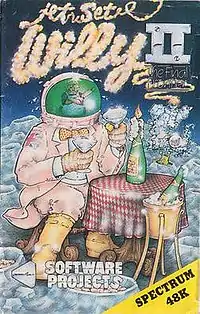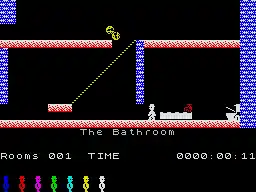Jet Set Willy II
Jet Set Willy II: The Final Frontier is a platform game released in 1985 by Software Projects for a variety of 8-bit home computers. It was the only official sequel to Jet Set Willy, one of the most successful home computer games ever released. Officially, Jet Set Willy II: The Final Frontier is the last of the Miner Willy series, although numerous unofficial sequels, remakes, homages and updates have been released, even up to this day.
| Jet Set Willy II: The Final Frontier | |
|---|---|
 Cassette cover from ZX Spectrum version | |
| Developer(s) | Derrick P. Rowson |
| Publisher(s) | Software Projects |
| Designer(s) | Matthew Smith |
| Series | Miner Willy series |
| Platform(s) | ZX Spectrum, Commodore 64, Amstrad CPC, Acorn Electron, BBC Micro, Commodore 16, Commodore Amiga, MSX |
| Release | 1985 |
| Genre(s) | Platform game |
| Mode(s) | Single-player |
Details

From the ZX Spectrum version
Jet Set Willy II is an expansion of the original JSW rather than a new game unto itself. Its map is primarily an expanded version of the original mansion, with only a few new elements over its predecessor, several of which are based on rumoured events in JSW that were in fact never programmed (such as being able to launch the titular ship in the screen called "The Yacht" and explore an island). In the ZX Spectrum, Amstrad CPC and MSX versions, Willy is blasted from the Rocket Room into space, and for these 33 rooms he dons a spacesuit.
Due to the proliferation of hacking and cheating in the original game, Jet Set Willy II pays homage to this and includes a screen called Cheat that can only be accessed by cheating.
Control of Willy also differs from the original:
- The player can jump in the opposite direction immediately upon landing, without releasing the jump button.
- Willy now takes a step forward before jumping from a standstill.
- The Willy character is mapped differently, so although Willy looks the same, some previous "safe spots" in Jet Set Willy are now hazardous to the player in Jet Set Willy II - the tall candle in The Chapel for example.
Jet Set Willy II was not written by the original programmer, Matthew Smith, and was instead developed by Derrick P. Rowson.[1]

Copy Protection and Anti-Piracy
Jet Set Willy II came with a form of enhanced copy protection called Padlock II. To prevent felt tip copying,[2] it had seven pages, rather than the single page used in Jet Set Willy.
Ending
The ending of JSW II is also different. Once Willy has collected 150 of the 175 available items and goes to bed, the game takes control of Willy and guides him into the bathroom, where he falls into the toilet - and lands in a room named Oh $#!+! The Central Cavern!, laid out identically to and deriving its name from the opening level of Manic Miner.[3] The screen is playable on the Amstrad CPC version, but there is no escape, save for the player intentionally killing off their remaining lives.
Ports
JSW II was originally created as an Amstrad version of Jet Set Willy (by Derrick P. Rowson and Steve Wetherill), but with expansions to exploit the 64K RAM of the Amstrad CPC range (compared with the 48K of the ZX Spectrum, the game's home platform). This version was subsequently ported back to the Spectrum. The porting across to Amstrad and porting back to Spectrum may also explain a number of other small differences, including the loss of coloured backgrounds in certain screens as the CPC version ran in a 4-colour display mode.
The game was subsequently ported to other platforms, including the Commodore 64, Commodore 16, BBC Micro, Acorn Electron and MSX. The BBC Micro cassette version has 2 rooms not in the ZX Spectrum version, and omits 60 of the rooms, rather than being a subset of it as are the CPC and ZX Spectrum versions.[4] Unofficial ports to the Acorn Archimedes, Windows/DOS and UNIX/X environments also exist.[5]
The C64 screen was a different format to the Amstrad, so the developers were unable to take the data used in the Amstrad and instead had to lay out again and re-implement all the screens and sprites. However, Rowson was able to use much of the data directly from the Amstrad, and hence the game was released sooner.
In an in-depth article about both the game and the code, Your Spectrum stated that as each room was compressed and took up differing amounts of memory, a room editor would be impossible to code.[6]
JSW2+
In November 2016 Rowson released JSW2+ as a re-write of JSW2. As well as technical improvements to the code allowing for more complicated rooms, it has built-in ‘cheat’ devices allowing infinite lives and teleportation. Rowson also added some new rooms, and made many of the rooms easier with fewer or slower sprites.[7]
References
- Martijn van der Heide. "Jet Set Willy II". World of Spectrum. Retrieved 23 December 2006.
- https://retrollection.net/2019/02/16/jet-set-willy-i-ii-software-projects-1984-1985-review/
- Jet Set Willy II: The Central Cavern
- "Jet Set Willy II: BBC Micro version". Retrieved 25 October 2010.
- "The DECWindows Archive - JETSET 1.0". DECWindows and VMS CENA's Archive. Retrieved 23 December 2006.
- Will Meet Again, Your Spectrum issue 18
- Jet Set Willy II: Updated, by Derrick P. Rowson
External links
- Jet Set Willy II at Curlie
- Map of the Spectrum version of Jet Set Willy II
- Room format for Jet Set Willy II
- Jet Set Willy II at SpectrumComputing.co.uk